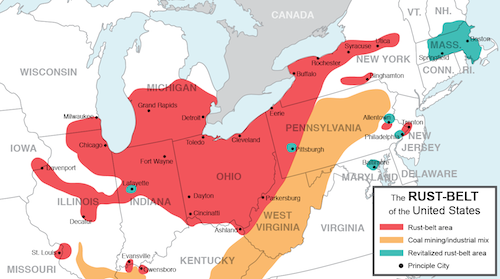Check out the map above; it’s all the designers in America, both self-employed and firm-employed, and across a wide spectrum of types of design (architecture, graphic design, etc.) It’s from an article by the great Richard Florida at CityLab that looks into where designers of different ilk tend to live. On this overall map you’re seeing above, very little should be jumping out at you — the hubs for design seem to be New York City, Los Angeles, San Francisco, and Seattle; those are all either tech hubs, fashion hubs, or general entertainment hubs. Minneapolis-St. Paul with a big circle might confuse you, but there are tons of marketing and advertising agencies in the Twin Cities — as well as places like General Mills, Target, 3M, and Medtronic, all of whom need oodles of designers in their own right.
These maps are roughly similar for specific professions — for example, if you look at the map for “Architects,” the top hubs are DC, Boston, Denver, San Francisco and Seattle (not necessarily in that order). If you look at “Graphic Designers,” you’ll see NYC, LA, SF, Chicago, Minneapolis, Seattle, etc. Basically, you see big coastal cities (and sometimes Minneapolis, Chicago and/or Austin) have high concentrations of this type of professional. But there’s one map where this all changes:
“Commercial and Industrial Designers” typically work on products like cars, toys and appliances. Look where they’re concentrated: Detroit, Indianapolis, Milwaukee, Cincinnati, and Providence. By and large, those are older, Rust-Belt-type cities. Indianapolis has a burgeoning start-up tech scene, yes, but “the book” on these places tends to be old Midwest centers in decline (Detroit’s decline has been one of the more terrifying and illuminating urban stories of the past decade or so).
This all begs the question: you see cities like Indy rising up, and also Pittsburgh — and you wonder, could these types of cities “rebound” on the backs of the commercial design possibilities already in their cities? After all, organizations look for access to talent when deciding where to put office hubs, so if commercial design is already rooted in a place like Milwaukee, well … could Milwaukee become a great turnaround story off of that?
At the very least, that’s food for thought — and your specific answer will probably depend on how you view the importance of a “design class,” as well as a host of other factors about the cities themselves and their ability to innovate and attract the millennial class. But it is interesting to think that, broadly, we usually think “designers” are clustered in large, urban, coastal cities; in reality, one of the largest sub-sets of designers (those who tend to make things that actually move or go) are already concentrated in the old Midwest.


